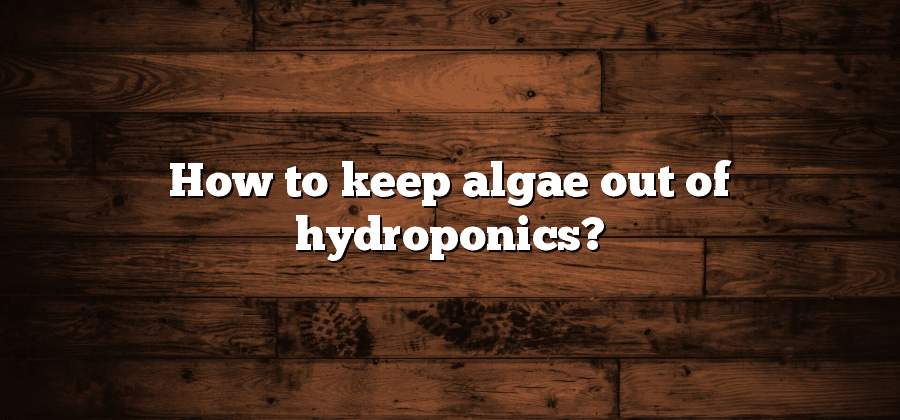Understanding Algae’s Impact on Hydroponics
Algae, a type of aquatic organism, can have a significant impact on hydroponics systems. It is important for growers to understand the potential effects of algae in order to properly maintain their hydroponic systems. Algae can thrive in hydroponic environments due to the ideal conditions they provide, such as the presence of water and nutrients. However, the presence of algae can lead to various problems that can hinder the growth and productivity of plants.
One of the main issues caused by algae in hydroponics is competition for nutrients. Algae can quickly multiply and absorb nutrients from the water, depriving plants of the essential elements they need to grow. As a result, plants may become nutrient deficient and display stunted growth or other signs of poor health. Additionally, algae can clog irrigation lines and filters, further disrupting nutrient distribution throughout the system.
Furthermore, algae can also create an environment conducive to the growth of harmful bacteria and fungi. The presence of excess algae can lead to a buildup of organic matter, providing a breeding ground for pathogens. These pathogens can attack the plants and cause diseases, leading to reduced crop yields or even crop loss.
Understanding the impact of algae on hydroponics is crucial for growers to effectively manage their systems. By implementing proper prevention and control measures, growers can ensure the long-term success and productivity of their hydroponic operations.
Importance of Maintaining a Clean Hydroponic System
Maintaining a clean hydroponic system is crucial for the success of any hydroponic operation. A clean system not only promotes healthy plant growth, but it also helps prevent the growth of unwanted algae. Algae can quickly multiply in hydroponic systems, leading to a range of issues such as clogged pipes, nutrient imbalances, and reduced oxygen levels in the water.
Regular cleaning and disinfection of the hydroponic system components, such as reservoirs, pipes, pumps, and grow trays, is essential to remove any organic matter or biofilm that may serve as a breeding ground for algae. This can be achieved by using appropriate cleaning agents and following the manufacturer’s recommendations. Additionally, it is important to regularly check and clean the filters in the system to prevent any debris or particles from accumulating and potentially promoting algae growth. By maintaining a clean hydroponic system, growers can ensure the optimal conditions for their plants while minimizing the risk of algae-related problems.
Controlling Nutrient Levels to Prevent Algae Growth
One crucial aspect of maintaining a clean and algae-free hydroponic system is controlling nutrient levels. Algae thrives in nutrient-rich environments, so it is important to carefully monitor and manage the nutrient solution in your hydroponic system.
To prevent algae growth, it is essential to maintain a properly balanced nutrient solution. This involves regularly testing the nutrient levels in your system and adjusting accordingly. Overfeeding your plants with nutrients can lead to an excess build-up in the water, providing an ideal breeding ground for algae. Additionally, fluctuations in nutrient levels can also contribute to algae growth. Regularly monitoring the pH and EC (electrical conductivity) levels of your nutrient solution will help ensure that they remain within the appropriate range for optimal plant growth while minimizing the risk of algae infestation.
Choosing the Right Hydroponic System Design
Hydroponic systems have gained popularity for their ability to efficiently grow plants without the need for soil. When it comes to choosing the right hydroponic system design, several factors need to be considered. The size of the system, the type of plants being grown, and the available space all play a role in determining the most suitable design.
One of the first considerations when selecting a hydroponic system design is the size of the system. A smaller system may be more suitable for hobbyists or those with limited space, while larger systems are better suited for commercial-scale operations. Additionally, the type of plants being grown will dictate the specific design requirements. Leafy greens, for example, thrive in vertical systems, while fruiting plants like tomatoes may require a more complex design.
Adequate space is another important factor to consider when choosing a hydroponic system design. Depending on the available area, options such as vertical towers, nutrient film technique (NFT) systems, or deep water culture (DWC) systems may be more feasible. The layout and arrangement of the system should also allow for easy access and maintenance, ensuring that plants can be cared for effectively.
In conclusion, choosing the right hydroponic system design requires careful consideration of various factors such as size, plant type, and available space. By selecting a design that aligns with these requirements, growers can optimize their hydroponic systems for successful and efficient plant cultivation.
Ensuring Sufficient Air Circulation for Algae Prevention
Proper air circulation is crucial in any hydroponic system to prevent the growth of algae. Algae thrive in stagnant, humid environments, making it essential to ensure sufficient air movement. By increasing the airflow within your hydroponic system, you create an unfavorable environment for algae to proliferate.
Adequate air circulation can be achieved through various methods, depending on the size and design of your hydroponic setup. One option is the use of fans or blowers strategically positioned to circulate air throughout the system. These devices can be placed near the reservoir to promote movement in the water, or positioned near the plants to ensure a steady flow across the leaves. Another approach is incorporating air stones or diffusers into the nutrient solution. These release tiny bubbles into the water, not only providing aeration for the plant roots but also creating turbulence and circulation that discourages algae growth.
By prioritizing sufficient air circulation, you can minimize the risk of algae infestation in your hydroponic system. The constant movement of air within the system disrupts the stagnant conditions that promote algae growth, providing a clean and healthy environment for your plants to thrive.






